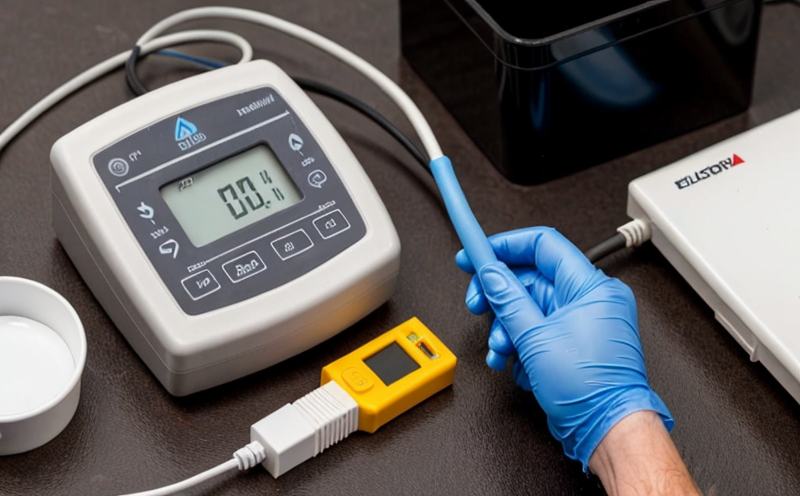ASTM F2129 Electrochemical Corrosion Testing of Implants
The ASTM F2129 standard provides a comprehensive approach to testing and evaluating the resistance of metal implants, particularly those used in orthopedic applications. This test is designed to assess the potential for corrosion under simulated physiological conditions, ensuring that medical devices are safe and effective for long-term use within the human body.
The significance of this test lies in its ability to predict real-world performance by simulating a range of environmental factors that can influence implant durability. By using electrochemical methods, ASTM F2129 helps manufacturers identify materials or design modifications that enhance stability and minimize risk. The tests are critical for ensuring compliance with regulatory standards and achieving product reliability.
The test methodology involves submerging the implant in a simulated physiological solution, typically phosphate buffered saline (PBS), and applying an electrical current to simulate physiological conditions. Specimens undergo various corrosion tests such as potentiodynamic polarization testing, hydrogen evolution, and weight loss measurements. These metrics help determine the implant's resistance to galvanic and stray current corrosion.
The importance of this service cannot be overstated in ensuring that medical devices meet stringent safety and performance standards. Compliance with ASTM F2129 is crucial for regulatory approval and market entry, particularly in countries where strict quality control measures are enforced. The test results also provide valuable insights to R&D teams, enabling them to refine designs and improve product longevity.
The data generated from these tests is essential for risk assessment and can influence decisions regarding material selection, surface treatments, and implant design. This information not only enhances patient safety but also contributes to the development of more robust medical devices that meet or exceed industry benchmarks.
Our laboratory adheres strictly to ASTM F2129 guidelines, ensuring accurate and reliable test results. We employ state-of-the-art equipment and experienced technicians to conduct these tests with precision and repeatability. The comprehensive approach we take ensures not only compliance but also a deeper understanding of the materials' performance under specific conditions.
The insights gained from ASTM F2129 testing are invaluable for quality managers, compliance officers, R&D engineers, and procurement teams. By leveraging this information, stakeholders can make informed decisions about product development, material selection, and regulatory compliance.
Why It Matters
The significance of ASTM F2129 electrochemical corrosion testing cannot be overstated in the field of medical device manufacturing. This test is a critical tool for ensuring that implants are safe and effective over their intended lifespan, which can span decades within the human body. The reliability of these tests directly impacts patient safety, reducing the risk of adverse events such as implant failure or corrosion-induced complications.
The electrochemical nature of ASTM F2129 allows for a more realistic simulation of the environments in which implants operate. This is particularly important given that many medical devices are subjected to complex physiological conditions, including varying levels of humidity, temperature, and stress. By replicating these conditions through controlled laboratory tests, manufacturers can identify potential vulnerabilities early in the development process.
The test results provide valuable data for quality managers and compliance officers, ensuring that products meet both internal standards and external regulatory requirements. This not only facilitates smoother market entry but also enhances brand reputation and trust among consumers. For R&D engineers, the insights gained from ASTM F2129 testing can lead to innovative improvements in design and material selection.
From a procurement perspective, this test offers assurance that suppliers are delivering high-quality materials consistent with industry best practices. The data generated supports informed decision-making regarding supplier evaluation and contract negotiations, ensuring long-term reliability of the supply chain.
The ultimate goal of ASTM F2129 testing is to minimize risk and enhance patient outcomes. By adhering to this standard, manufacturers can contribute to a safer healthcare environment, ultimately improving the quality of life for patients who rely on these medical devices.
Applied Standards
| Standard | Description |
|---|---|
| ASTM F2129-08(2016) | This standard specifies the procedure for electrochemical corrosion testing of metal implants to simulate physiological conditions. It covers various test methods, including potentiodynamic polarization and hydrogen evolution. |
| EN ISO 5832 | A European standard that provides requirements for metallic materials intended for use in medical devices, particularly those used in orthopedic applications. |
| ISO 10993-18 | This international standard covers the biological evaluation of medical devices, including considerations related to corrosion resistance. |
The application of these standards ensures that our testing aligns with global best practices, providing clients with confidence in the reliability and safety of their products. Compliance with ASTM F2129 is a key indicator of adherence to high-quality manufacturing processes and rigorous quality assurance measures.
Scope and Methodology
| Methodology | Description |
|---|---|
| Potentiodynamic Polarization Testing | This method measures the anodic and cathodic behavior of the implant material under varying potentials, providing insights into its corrosion resistance. |
| Hydrogen Evolution Testing | This technique assesses the amount of hydrogen gas produced during the test, which is indicative of galvanic corrosion tendencies. |
| Weighing Method | The weight loss of the implant over time provides direct evidence of material degradation due to corrosion processes. |
The scope of ASTM F2129 testing is broad, encompassing a range of parameters that evaluate an implant's resistance to various types of corrosion. The methodologies employed are designed to simulate the diverse conditions encountered in real-world applications, ensuring comprehensive evaluation and accurate results.
Our laboratory uses advanced equipment and experienced technicians to conduct these tests with precision and repeatability. This ensures not only compliance but also a deeper understanding of the materials' performance under specific conditions. The insights gained from these tests are invaluable for quality managers, compliance officers, R&D engineers, and procurement teams.





